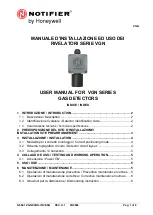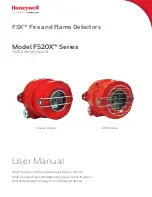
4. How to Use
4-6. How to detect
- 23 -
4-6. How to detect
When the preparation for start-up and air calibration have been completed, put the probe close to the
detection area in the detection mode and perform gas detection.
Reading display (example)
・
CH4 concentration: 0.0 vol%
・
Detection range: 0 - 10.0 vol% (Low
RANGE)
・
Range mode:
Automatic switching
(Auto)
・
Battery level:
Low
・
Time:
20:18
WARNING
•
The gas detector is designed to draw gases under the atmospheric pressure. If excessive
pressure is applied to the gas inlet and outlet (GAS IN, GAS OUT) of the gas detector,
detected gases may leak out from its inside and may cause dangerous conditions. Be sure
that excessive pressure is not applied to the gas detector while used.
•
Do not connect the sampling hose directly to a location with a pressure higher than the
atmospheric pressure. The internal piping system may be damaged.
•
When the fresh air adjustment is performed in the atmosphere, check the atmosphere for
freshness before beginning the adjustment. If interference gases exist, the adjustment
cannot be performed properly, thus leading to dangers when the gas leaks.
•
When the gas detector triggers a gas alarm while “Alarm setpoint setting” (P. 46) is
configured, it may indicate an extreme danger. In this case, take proper actions based on
your judgment.
•
Issuance of a gas alarm while the gas detector is used for the purposes such as explosion
prevention indicates that there are extreme dangers. Take proper actions based on your
judgment.
•
Before use, check that there remains sufficient battery power. When the gas detector is not
used for a long period, the batteries may be exhausted. Never fail to replace them with new
ones before use.
•
If a low battery alarm is triggered, gas detection cannot be conducted. If the alarm is
triggered during use, turn off the power and promptly replace the batteries in a safe area.
•
Do not block the buzzer sound opening. No alarm sound can be heard.
•
If the main unit is dropped or given a shock, the reading may rise and it may remain so. In
such a case, perform air calibration in a place where the surrounding air is fresh.
CAUTION
•
Before performing gas detection, attach the gas sampling probe provided with the gas
detector to prevent disturbances by air dust.
DANGER
•
While conducting measurement in a confined space such as inside of the gas storage tank
and pipeline, do not lean over or look into the gas storage tank or pipeline. It may lead to
dangers because oxygen-deficient air or other gases may blow out.
•
Oxygen-deficient air or other gases may be discharged from the gas exhausting outlet. Never
inhale the air or gases.
•
High-concentration combustible gases may be discharged. Never use fire near it.














































